When it comes to monitor arms, there are a lot of good things about them. They help save space on your desk and make it more comfortable to look at your screen from the right angles. But here’s the big question: If you spend only $30, do you get the same benefits as you would with a $100 or even a $400 monitor arm? We’re going to figure out if the price matches up with what they offer.
Full Disclaimer: We are an office furniture dealer and sell some of the products we review. To learn more about the products we sell, our review process and why you can trust us, please visit: Why we’re different. Who is BTOD.com and The Breakroom Blog?
Cheap Vs Expensive Monitor Arms
You can find entry-level monitor arms like the VIVO basic on Amazon for just $29. These arms use a c-clamp to attach to your desk, and they also come with grommet mount systems. Most models in this price range are simple pole mount systems.
Attaching your monitor to the VESA bracket on the arm allows you to easily tilt and pivot your screen. Adjusting the height is a bit more complicated; you need to loosen a bolt, but once you find the right height, you’re likely to leave it that way.
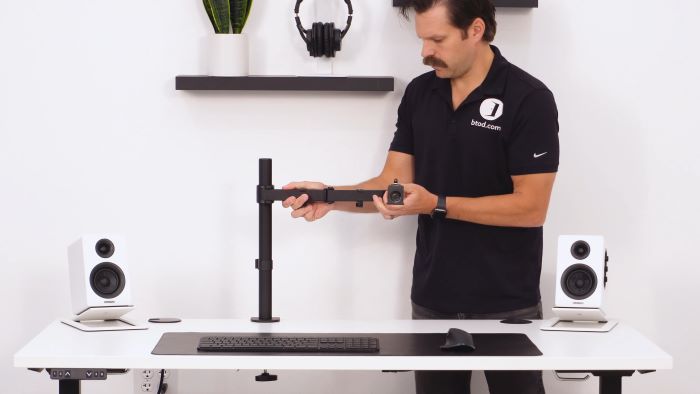
Next is the popular Huano spring which can be purchased for only $39.99. This arm attaches to your desk with the C clamp making it a quick and efficient setup. The key distinction between these two entry-level arms lies in how you adjust the height.
The Huano uses a spring-assisted system, making height adjustments a breeze – simply grab the monitor and move it up or down. Similar adjustments for pivoting and tilting can be easily made as well.
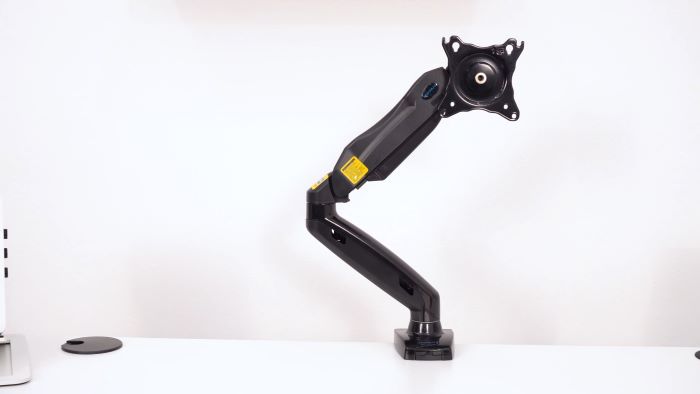
When it comes to cable management, these entry-level arms share a nearly identical design throughout the category. Although the process may be a bit of a hassle, the end result looks better than most entry-level post systems.
However, it’s essential to note a drawback of the cheaper spring systems: their weight capacity. The Huano, for instance, is only rated up to 14.3 lbs compared to the 22 lbs capacity of the more basic post system. Overall, the build quality of the entry level is what you’d expect for the price. It won’t really blow you away, but it gets the job done.
To follow is the AmazonBasics arm. It is our first look into the mid-range level for monitor arms and is currently unavailable on Amazon. One of the first things that you notice about this arm is how much better built it is than the entry level products.

Looking closely at the bases of the desk-attached arms, the AmazonBasics arm stands out as being sturdier, a consistent theme throughout the rest of the arm. It’s important to note that while some users claim it can support 49” ultra-wide monitors, my experience contradicts this. When I attached a 49” ultra-wide monitor, the weight caused a permanent downward tilt.

The craziest part about this arm is the fact it is very similar to the Ergotron LX. The key difference that I noticed lies in the base size, otherwise they look and feel and feel the same. This might explain why the AmazonBasics arm has been consistently listed as unavailable on Amazon, perhaps indicating a potential clash with Ergotron over pricing on essentially the same product.
Offering a compelling alternative in the same price range as the AmazonBasics at $119, the VIVO heavy-duty monitor arm proves to be a great option, and the good news is that it’s readily available. While the build quality might not quite match that of the AmazonBasics, the VIVO heavy-duty does do certain things better.
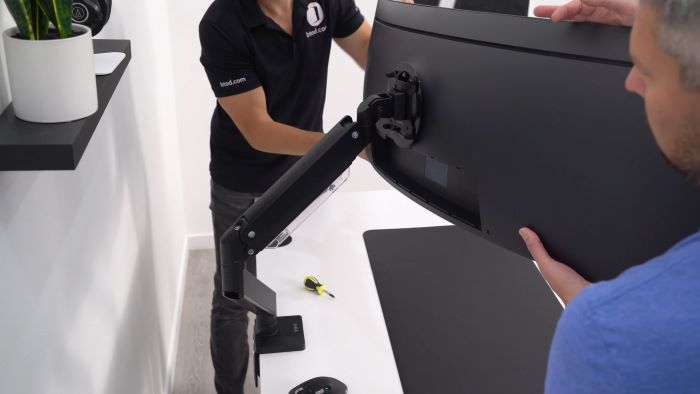
The most obvious is it has the capacity to support a 49” ultra-wide monitor, a feature that sets it apart. Adjusting the arm is a breeze, thanks to the spring-assisted height adjustment. The inclusion of cable management, though not the most intuitive to set up, but once completed it does a good job keeping the wires in place.
VIVO has also recently introduced what looks like a potential replacement for this arm and retails it for even less at only $99. On paper, it appears that it does all of the same things, for $20 less.
The Ergotron LX stands out as a premium product with a retail price around $247, and the overall build quality justifies the cost, especially if the more affordable option from AmazonBasics is no longer available. In terms of appearance and feel, the LX surpasses anything I’ve experienced with entry and mid-range products. The fit and finish is on point and the adjustments are smooth.
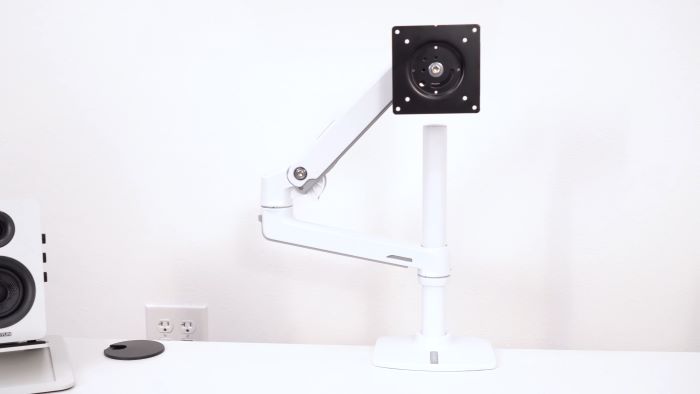
Attaching the monitor to the arm is a straightforward process, although a removable VESA plate would have made it even easier. Detaching the upper arm to connect it to your monitor is a simple solution. Customization options include various post heights, and I’ve found the 13” height pole to offer great flexibility in raising the monitor higher. On the downside, the cable management on this system is a bit of a miss, with zip ties being included that hook onto the upper portion of the arm.
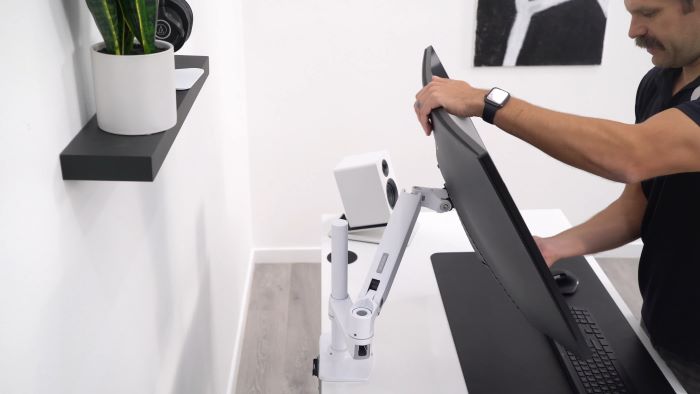
The lower arm has a plastic cover that hides the wires as they go down to your desk surface. This model isn’t made for ultra-wide monitors though, so we wouldn’t recommend using monitors that are larger than 34 diagonally, with a max weight of 25 lbs.
Lastly, if you’re looking to support an ultra-wide monitor, or something up to 42 lbs, the Ergotron HX is the premium option to consider at $405. When you compare the LX and HX side by side, they might look similar, but the overall build of the HX is significantly more. The base itself is more heavy duty, which I think most of us using ultra-wide or tv’s as monitors would appreciate.
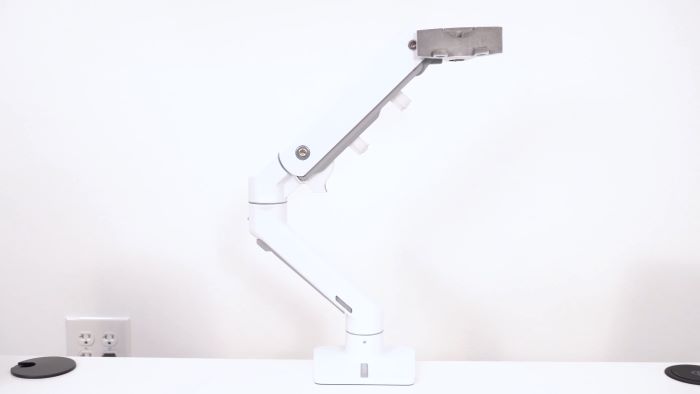
The actual arm components themselves are more robust, which is important for supporting monitors, especially when they are extended far away from the mount to the desk. The biggest difference between the Ergotron HX and LX is in the design of the tilt and pivot head. When shown side by side, you can tell the spring system is significantly larger and this is the case when compared to all of the mid and entry level alternatives.
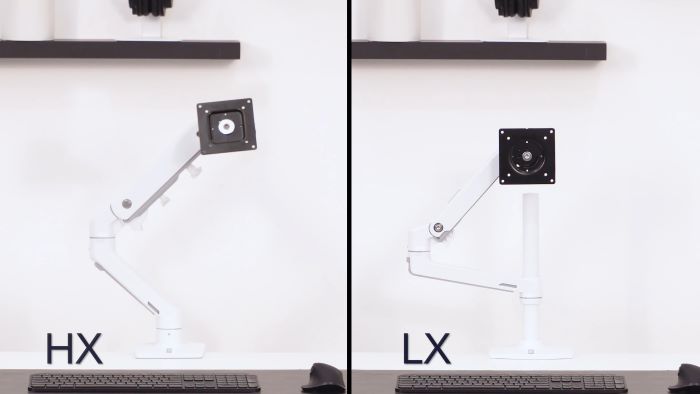
The bracket itself is also quite a bit sturdier which is great for heavy monitors, but if you’re planning to use a standard monitor that is say only 24” I would avoid this arm, since there won’t be enough weight to tilt the monitor down in a neutral position.
Unfortunately, the cable management on the HX is similar to the LX and could be improved upon. The difference being that they include Velcro straps versus the cheaper zip ties and they are not just hung on a hook, but instead channeled through the upper arm.
Bottom Line
Ultimately, the world of monitor arms offers a wide variety to cater to everyone. This can depend on individual needs, budget, and specific demands of one’s workspace. Choose a monitor arm wisely and consider all pros and cons.




